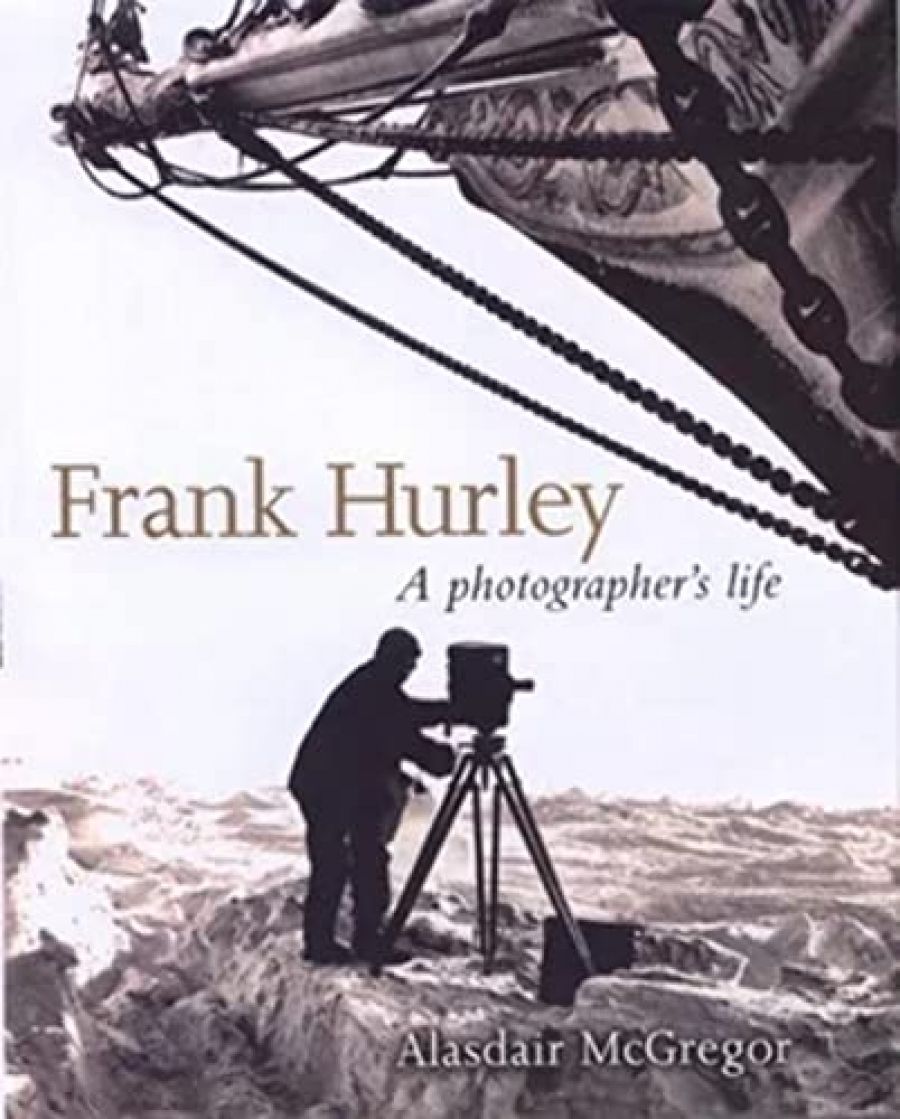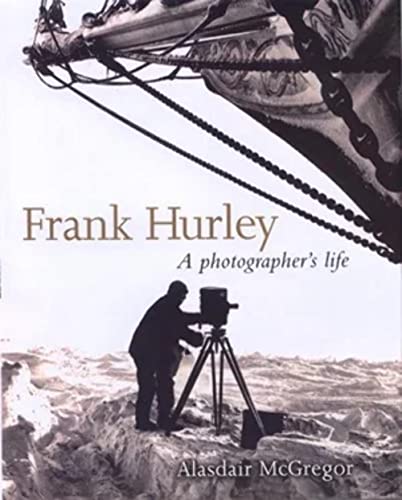
- Free Article: No
- Contents Category: Memoir
- Review Article: Yes
- Article Title: Number One All the Time
- Online Only: No
- Custom Highlight Text:
From his precocious youth in inner-city Sydney until his death – still in harness at the age of seventy-five – the Australian photographer Frank Hurley lived for ‘adventure and romance’. By any standards, his was an extraordinary career. Yet the individual delineations of its great landmarks have blurred in the factual catalogue of Hurley’s achievements in two Antarctic expeditions during the cradle period of exploration in that great southern continent; in his work as an official photographer during the two world wars; in his pioneering of filmed documentaries and as a cinematographer in the making of major Australian feature films in the 1930s. In the last twenty years of his career, Hurley travelled the length and breadth of his own country, celebrating its people and eulogising what he saw to be the heroic Australian landscape. Always restless, always yearning for the next challenge, Hurley was a citizen of the world. He was drawn to record the cultures of the ancient world and, closer to home, aspects of New Guinea and the Pacific. - Book 1 Title: Frank Hurly
- Book 1 Subtitle: A Photographer's Life
- Book 1 Biblio: Viking, $65hb, 460pp
- Book 1 Cover Small (400 x 600):

- Book 1 Cover (800 x 1200):

For his Antarctic photographs, taken in the most difficult and trying of conditions during the expeditions with Douglas Mawson (1911–14) and Ernest Shackleton (1914–16), Hurley has an honoured place in the annals of world photographic history. Popular understandings of Antarctica – its extraordinary beauty and its manifest physical challenges – are enduringly shaped by Hurley’s images. Some sense of the horrors and waste of war is still communicated by his photographs of the shattered towns and villages along the Western Front in 1917. No survey history or exhibition of Australian photography in the twentieth century is complete without the inclusion of iconic examples of Hurley’s work, as witnessed in the current National Library of Australia show, In a New Light: Australian Photography 1850s–2000, curated by Helen Ennis.
But for all the honour due to Hurley’s work, there has been a sense that the man himself has slipped from the national memory since his death in 1962. Part of the reason for this may be that Hurley’s machismo and his obvious social conservatism has proved uncongenial to a more recent Australian audience. While historians have readily acknowledged Hurley’s importance – but also conceded his flaws – the punters have found greater pleasure and relevance in the more subtle and varied textures of work created by Max Dupain, Olive Cotton and David Moore, and of the prolific generation of photographers born after 1945. Hurley was not much given to self-reflection but, in a letter of August 1943 to his younger colleague and rival, the supremely talented Damien Parer, he allowed himself to apologise for being a ‘surly old bugger’. And just as Parer had perceived in the older man some essential limitation of imagination, there is a suspicion that this came to be discerned also in the wider consciousness of Australians and that Hurley was judged accordingly and found wanting.
History, though, is the constant task of assessment and of reassessment, and perhaps the time has come to re-examine James Francis Hurley in the light of his full creative range and of an extraordinary career, and of his remarkable achievements. Who better to undertake this task than Alasdair McGregor, himself a skilled environmental photographer and an Antarctic traveller, as well as a capable writer and historian?
McGregor has produced a large and handsome book – indeed a monumental life – and one that is superbly illustrated with more than 100 photographs, some of them never previously published. This new landmark study is written with respect and admiration, but also with a discerning awareness of the problems presented by his subject’s driving ego, his chauvinism and conservatism, and his own relentless myth-making. Parer observed at first hand that Hurley ‘must be number one all the time’. McGregor brings a refined and educated sensibility to his examination of an important Australian life: he does his work with respect and admiration, but never with the gush of hero-worship. A clear strength of the book is the author’s informed understanding of the several physical contexts in which Hurley created his work, especially in Antarctica, and of the changing technologies of photography itself over the years in which Hurley was active. As the historian Peter Cochrane has done recently, McGregor brings a judicious eye to his examination of the vexed question of Hurley’s manipulation of images (especially in the World War I photographs), which was intended to heighten dramatic and psychological effects, but which may have distorted reality.
As with the life itself, this is a rich and interesting book. One of its strengths is McGregor’s deft understanding and presentation of historical context, especially in his narrative of Hurley’s sojourns in Antarctica and later of the circumstances that affected the production of photographs and of documentary film in the two world wars. A clear understanding of Hurley’s relative failure as a photographer in the Middle East in the 1940s is conveyed both in terms of his age and of his dependence on the heavy old-fashioned equipment that had served him well in previous times but that was awkward and clumsy in the mechanised circumstances of desert fighting in a new era of warfare. Where Hurley struggled with his tripod and his fixed camera, the younger Parer and George Silk from New Zealand made effective use of their much lighter hand-held equipment. Their frustrations with Hurley were great and never really resolved.
If there is a difficulty with this overdue examination of Hurley’s life, it lies in the more personal domain of intimate relationships, and especially of his long marriage to Antoinette Rosalind Leighton. The couple had met in Egypt in 1918 and had married after a ten-day courtship. But in the years that followed, there were long separations as Hurley again and again left home to pursue his own interests and his career. There were four children from the marriage, and two of them – the twins Frances Antoinette and Sidney Adelie, born in May 1919 – have been the especially proud guardians of their father’s reputation and memory. But the marriage story is one of silences and of ambiguities. McGregor recognises the difficulty, and sometimes poses sharp questions. In terms of biographical enquiry, however, the matter, the dynamics, the causes and the eventual consequences of Hurley’s behaviour in the conduct of his most intimate personal relations are not sufficiently analysed or explained. In what must stand for the foreseeable future as the definitive biography, is it enough to say that Hurley’s absences ‘had fashioned a void of sadness and disillusionment’ in Antoinette’s life? This had led her, in the end, to be ‘indifferent to the very word “photography”’. This was a bleak comment indeed on a life whose very essence derived not from any living person but from the beguiling images and possibilities to be conjured from the manipulations of the ‘mechanical eye’.


Comments powered by CComment